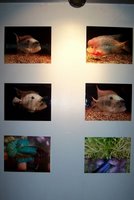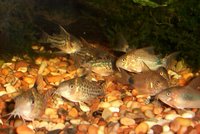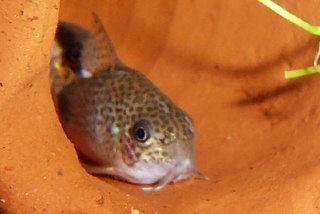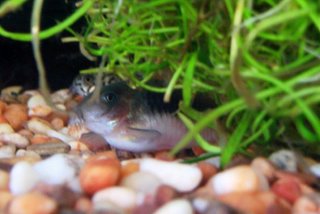 Having a bit of a pickle with the PC. It zonked out on me a week ago and as consolation, I treated myself to a trip to Cartimar last Wednesday, November 23, 2005. Stinky as hell but the shopping arcade is Manila's pet central selling all sorts of pets and supplies. Metro petshop has new stocks of c. schwartzi. They are selling for 230 pesos each which was cheaper than how much they were selling before at 350 per. They had good specimens, very healthy looking and shiny at the scales. At closer scrutiny though I've noticed that some of them had black spots on the dorsal fin that extended briefly at the top part of the body. It is a negligible detail except when you know that another species answer to this description-- the c. leucomelas. Leucomelas look very much like C. schwartzi except where the schwartzi has a white to translucent dorsal fin with some sprinkling of black dots, the leucomelas has a very distinctive black spot on the dorsal. Hence, the confusion. This lone spot on the dorsal fin is similar to that of the C. ambiacus, hence it is fairly possible that some c. ambiacus specimens can be mixed in with the schwartzi in the LFS. The schwartzi are now sold at 230 pesos compared to the 350 before. The leucomelas/ambiacus were sold at 90-100 pesos. I got one with the spotted dorsal. I figured, what ever name it answers to it is still a nice looking cory.
Having a bit of a pickle with the PC. It zonked out on me a week ago and as consolation, I treated myself to a trip to Cartimar last Wednesday, November 23, 2005. Stinky as hell but the shopping arcade is Manila's pet central selling all sorts of pets and supplies. Metro petshop has new stocks of c. schwartzi. They are selling for 230 pesos each which was cheaper than how much they were selling before at 350 per. They had good specimens, very healthy looking and shiny at the scales. At closer scrutiny though I've noticed that some of them had black spots on the dorsal fin that extended briefly at the top part of the body. It is a negligible detail except when you know that another species answer to this description-- the c. leucomelas. Leucomelas look very much like C. schwartzi except where the schwartzi has a white to translucent dorsal fin with some sprinkling of black dots, the leucomelas has a very distinctive black spot on the dorsal. Hence, the confusion. This lone spot on the dorsal fin is similar to that of the C. ambiacus, hence it is fairly possible that some c. ambiacus specimens can be mixed in with the schwartzi in the LFS. The schwartzi are now sold at 230 pesos compared to the 350 before. The leucomelas/ambiacus were sold at 90-100 pesos. I got one with the spotted dorsal. I figured, what ever name it answers to it is still a nice looking cory.For more info on identifying the spotted corydoras, check out this article: http://www.corycats.com/art%2002_the_spotted_ones.htm
























